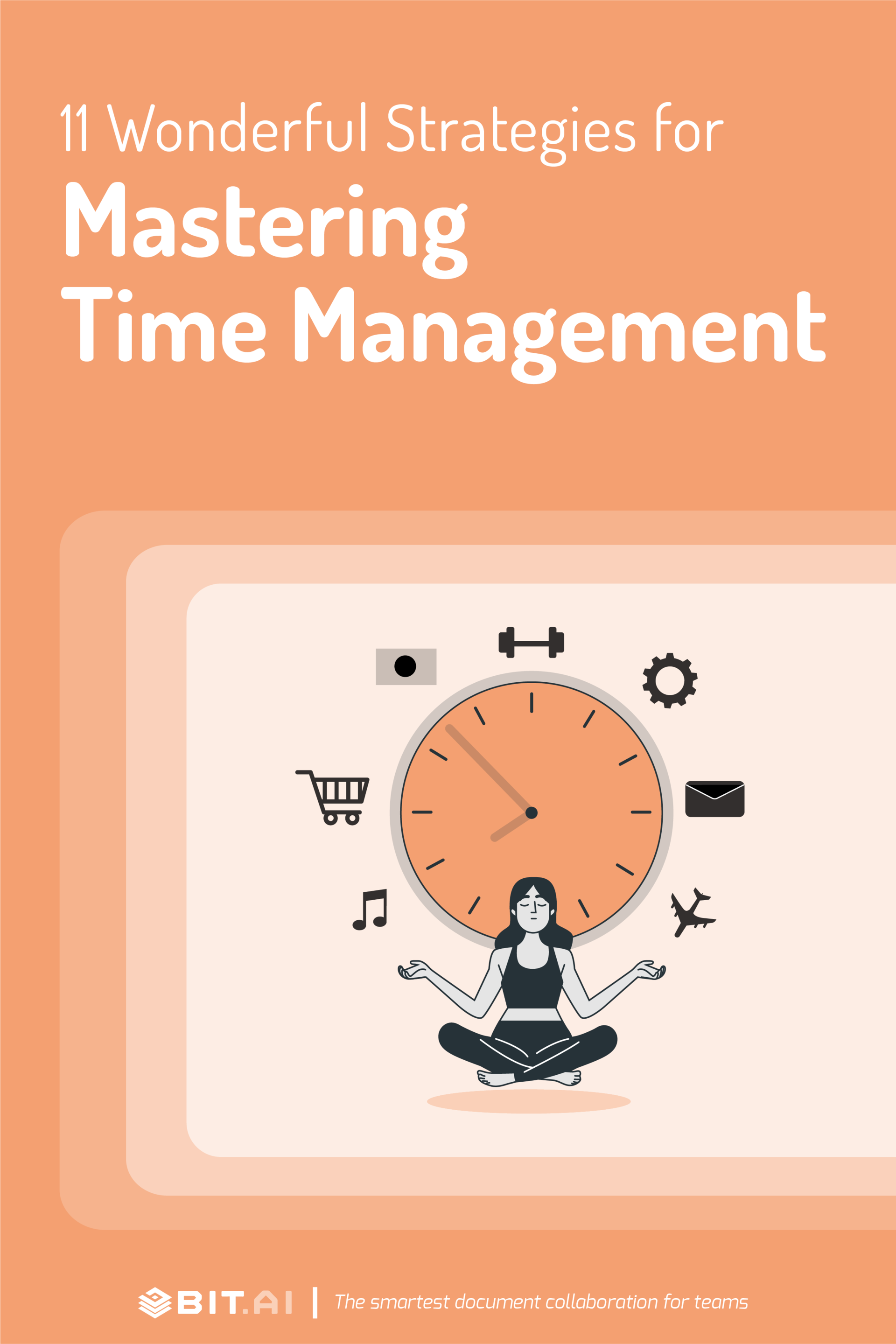The bad news is time flies. The good news is you’re the pilot. -Michael Altshuler
“From now on, I’ll be more productive, manage my time better, and focus on what matters.” – We all have said these words to ourselves more than a hundred times.
However, a few days after making this ultimate resolution, we again find ourselves with slipping deadlines and a never ending to-do list vying for our attention.
Because let’s be honest, time management is always an issue for most of us.
Life throws surprises at us all the time, deadlines change, new projects come up – completely dismantling our carefully drafted schedules. More often than not, we can’t even anticipate these interruptions.
It’s disheartening, but it doesn’t have to be this way because you can actually accomplish all the tasks that you want to accomplish.
For that, you first need to know that you can’t really “manage” time because time is a fixed resource and it plays no favorites. No one can store time, borrow it, or save it for later use. (It is what it is!)
There are only 24 hours in a day, 60 minutes in an hour, and, 60 seconds in a minute. For every single one of us.
But then why does it seem that some people are able to get the most out of every minute of the day? Do they have the power to slow downtime?
Well, of course not. The only power they have is knowing how to properly manage their time, and this blog will give you that power too!
See, time management is more about simplifying how you work, and getting things done faster. It’s all about managing your time instead of letting it manage you.
We promise you – there really are enough hours in a day for everything you’d like to do. All you need to do is learn and adopt some cool time management strategies that’ll help you tame the time monster. Ready? Let’s go!
1. Create a Time Audit
Do you always struggle to achieve your goals? Do you always run out of time but you’ve no idea why? Are you always “busy” but still never get anything done?
Well, if you said “yes” to even one of these questions, it’s time for you to start auditing your time.
A time audit is exactly what it sounds like: keeping track of what you do during the day. By knowing exactly where your time goes, you can identify the biggest “time wasters” in your day.
One of the ways to do a time audit is to just keep a log of your time. Once done, dig deeper into exactly how your time was spent and ask yourself:
- How much do I spend on distracting activities?
- How much of my work hours are actually spent on doing work?
- How do I spend my post-work hours?
After you’ve analyzed which activities are productive or inefficient, start making changes. Cut out time-wasting activities, and create more space for the important ones!
2. Follow the 80-20 Rule aka The Pareto Principle
A little back story: This theory was developed by Pareto while observing pea plants in his garden. He noticed that 80 percent of his pea harvest came from just 20 percent of the pea plants that he grew. After he investigated the theory more and more, he discovered that this 80/20 split can be applied to almost every other area too.
For now, let’s focus on time management. You might be spending too much time on things that aren’t going to help you truly achieve what you want.
However, to achieve balance in your life, you need to put the most effort into things that give you the most back, and you can do that by applying the 80/20 rule.
Take a piece of paper, pen down all your tasks and ask yourself: If you could only achieve one goal from the list, which one would make the highest impact on your success?
Now, pick the second most important goal.

After you’ve finished this exercise, you’ll know the most significant 20 percent of your goals that will help you more than anything else.
Simply put, this time management strategy is all about aiming for the high-value tasks and goals first, rather than doing the smaller ones that don’t offer a big pay-off!
Read more: 7 Best AI Tools For Time Management
3. Set up Deadlines
The truth is, you don’t have forever to finish your project at work, go to the gym and spend time with your family. This limitation is what makes setting deadlines and sticking to them extremely important.
It’s actually very easy – just estimate how long each task on your to-do list will take and then set realistic deadlines for yourself. (Don’t forget to consider the time for your other commitments!)
Here are some of tips that will help you while setting deadlines:
- Give yourself early completion deadlines. They act as a buffer for unforeseen emergencies.
- Regularly analyze and update upcoming deadlines.
- Set reminders for your deadlines.
Setting deadlines is the best thing ever because they give you a roadmap on how much time you’ve to complete a task, helping you adjust your effort and speed accordingly.
Also, deadlines create a sustained pressure to perform. Don’t worry – it’s all worth it because the feeling you get when the deadline is met is priceless.
4. The Pomodoro Technique
Developed in the late 1980s, this technique is the brainchild of a university student named Francesco Cirillo. Just like every other student, Cirillo was struggling to focus on his studies and complete his assignments.
He then asked himself to commit to just 10 minutes of focused study time, found a tomato-shaped kitchen timer in his kitchen, and the Pomodoro technique was born. (Pomodoro is Italian for Tomato. 🍅 )
That means you don’t need any fancy app for this really wonderful time management strategy, all you need is a timer. Here’s how it works:
- Create a list of all the things you need to accomplish.
- Set your timer for 25 minutes, and put all your focus on one task until the timer rings.
- When the timer rings, mark an X next to the activity you’ve been working on.
- Then enjoy a five-minute break. These intervals are referred to as pomodoros.
- After exactly four pomodoros, you can take a longer break of about 15 to 30 minutes.
- Repeat this cycle until you’ve finished all of your tasks for the day.
- And of course, do not forget to give yourself a pat on the back for the job well done!
When you’re just starting out with the technique, you might feel the urge to stir things up, but remember:
- A pomodoro can’t be interrupted, it marks 25 minutes of pure work! If you face any unavoidable disruption, just take a five-minute break and start again.
- You are not permitted to keep on working “for a few more minutes” even if you’re sure that in those few minutes, you could finish the ongoing task.
This time management strategy encourages you to work with the time you have – rather than against it!
Read more: 9 Daily Planners You Can Use to Improve Your Productivity!
5. Eat the Frog
You are most probably wondering what swallowing a frog has to do with time management.
Actually, ‘the frog’ symbolizes the tasks that you have the least interest in doing. So, don’t panic because ‘eat the frog’ is a metaphor devised by Brian Tracy in one of his books.

Inspired by Mark Twain’s quote, Brian Tracy wrote:
“If the first thing you do in the morning is to eat the frog, then you can continue your day with the satisfaction of knowing that this is probably the worst thing that will happen to you all day”.
The reason? You’re in your best shape in the morning. So, instead of wasting your energy on completing secondary tasks, use it to accomplish the biggest, most important, and most dreaded tasks.
As soon as finish all those dreaded tasks, you won’t just feel a sense of accomplishment, but doing the rest of the tasks would be a breeze.
Honestly, just like breakfast is the most important meal of the day, the first task you finish will fix the tone for the rest of your day!
Read more: 10 Best Productivity Hacks to Lead a Better Life!
6. Triage Technique
Even though this time management strategy was invented during the Napoleonic wars to assign degrees of urgency to illnesses of soldiers, you can still use it!
All you’ve to do is sort your tasks into four different categories:
- Things that need immediate action. (Important and urgent)
- Things that are less serious but could become serious if not taken care of. (Important but not urgent)
- Things you can do when you have got the time. (Urgent but not important)
- Things that are just a waste of time (Not urgent and not important)
Just imagine that you’re in a super busy emergency ward, and you’ve to find the best order and care for each new patient, or task.
7. BuJo – The Bullet Journal
Bullet journals are the rage these days, but why is there so much hype over a simple notebook with a bulleted to-do list?
Because a bullet journal helps you keep track of everything in your busy life. It’s more of a life hack, a physical place to store everything you need to do and remember.
With sections to log your daily to-do’s, monthly calendar, notes, and more, bullet journaling turns the chaos of coordinating your life into a streamlined system!
Want to be a BuJo pro? Use these following symbols:
- Write an “x” to mark to-dos that are now complete.
- Draw the less than symbol (<) over the bullet to show that that task has been scheduled.
- Draw the greater than symbol over it (>) to show that you moved the task to another time.
- Use a dash for quick thoughts and notes.
- Draw an open circle to mark big events.
8. The Glass Jar: Rocks, Pebbles, Sand
Ever heard the story about a philosophy professor who gave a lecture about the importance of not cramming your ‘jar’ with small rocks and sand?
So, in the story, the professor has a big glass jar, a pile of rocks, a bag of small pebbles, a bottle of water, and a tub of sand in front of him.

He fills the jar to the brim with large rocks and asks his students if the jar is full. They all agree that there is no more room for anything else.
He then adds the pebbles to the jar, shakes it so that the pebbles disperse themselves among the rocks. Then he asks again, “Is the jar full now?”
The group of students look at each other and agree that the jar is now really full.
The professor now pours sand and water into the jar to fill up any remaining space and goes on to explain that the jar of rocks, pebbles, sand, and water represent everything that is in one’s life.
You need to make room for what’s important. If you deal with the big tasks first by putting the rocks in the jar first, the small tasks can still be accomplished. However, the reverse is not true at all!
So, take the time and assign each task into a pile of either sand, pebbles, or rocks, while the jar being your life.
- Rocks: These represent the most important tasks that have real value, tasks that need your utmost attention.
- Pebbles: They represent the tasks that matter, but the ones that won’t make an immediate difference to your projects/working week.
- Sand & Water: They represent everything else – the small stuff that won’t make any difference to your working week.
9. 168 Hours
You get 168 hours in a week, and if you’re wondering why we are measuring time weekly instead of the usual “24 hours a day”, you’re about to find out.
See, most of the tasks that we do throughout the week are recurring or continuing activities, right? So, the best way to schedule the day is to see that day as a part of the entire week.
Activities like working out, reading a book, sleeping – it’s best to measure them as a weekly average because the exact timings of these things might vary each day.
Another reason why this time management strategy is useful is that a day is actually a short span to effectively understand how you spend your time.
Let’s say you spend 40 hours a week at the office, sleep for 8 hours a day, watch TV for 6 hours a day and take around 5 hours a day to cook and eat your food.
This still gives you 109 hours a week to do other tasks, something you won’t have been able to figure out if you followed the 24 hours a day strategy!
So it’s best to have weekly goals rather than daily ones for these activities!
10. The Eisenhower Matrix
“What is important is seldom urgent and what is urgent is seldom important”, said Dwight D. Eisenhower, USA’s 34th president and also the one who created ‘The Eisenhower Matrix‘.
This time management strategy improves your productivity by teaching you how to prioritize better. It helps you in finding out which activities are worth your time and effort, and which ones aren’t.
Much like the Triage Technique, in the Eisenhower Matrix, you’ve to divide all of your day-to-day tasks and bigger projects into four quadrants: Do, Decide, Delegate & Eliminate!
The main aspect of this entire matrix is differentiating between urgent and important tasks.
Urgent tasks are the ones that you need to deal with as soon as possible. For example, studying for an exam you totally forgot about or taking an injured friend to the hospital.
Whereas, important tasks are the ones that are not time-sensitive and they might not hamper your success. For example, planning a trip, or a diet to get healthier.
And in a world where we’re always pulling all-nighters to keep up with our schedules, it is a priceless skill.
Read more: 6 Expert Tips to Perfect Your Time Blocking Strategy
11. Set Buffer-Time
Usually, when you decide that you want to be more productive, you rush straight into it. You want to get more done, which might seem like the right choice, but it’s actually a problem.
Because when you focus solely on the “quantity” of work that you can get done, you lose sight of the quality and you might not even finish your most important tasks.
The solution? Include buffer time between your tasks.
Think of buffer time as the spaces between words in a sentence. It’s the difference between “Jack & Jill went up to a hill” versus “Jackandjillwentuptothehill.”
The spaces are what helps you keep things properly managed!
So, allow yourself to have a little rest time between your tasks. Go for a walk or watch one episode of your favorite show to recharge your mind before you get back to work.
No, it’s not called being lazy, it’s called being intelligent! After all, your brain needs a break every 90 minutes to maintain the highest levels of concentration and motivation.
Wrapping Up
We’ve all experienced the woes of time management. Work, family, hobbies – we’re constantly racing against the clock to balance all of it. If only we got 25 hours in a day!
But, adopting good time management strategies in your life isn’t about squeezing as many tasks as you can into your day. It is NOT about being busy, sleep-deprived, and constantly on the go.
Time is tricky and therefore, it’s important to understand what you need to do, what you want to do, and how long each task will take.
So, apply the time management strategies we shared and see how your life changes for the better. Believe us, once you master the art of time management, your days of wanting a time machine will be over!
This quote by H. Jackson Brown Jr will put everything into perspective for you:
“Don’t say you don’t have enough time. You have exactly the same number of hours per day that were given to Helen Keller, Pasteur, Michaelangelo, Mother Teresa, Leonardo da Vinci, Thomas Jefferson, and Albert Einstein.”
Further reads:
- Focus at Work with the Help of These 11 Effective Ways!
- Best Focus Apps to Eliminate Distractions!
- 13 Productivity Tools That Will Help You Achieve More in Less Time!
- 15+ Schedule Maker Tools You Should Try This Year!



